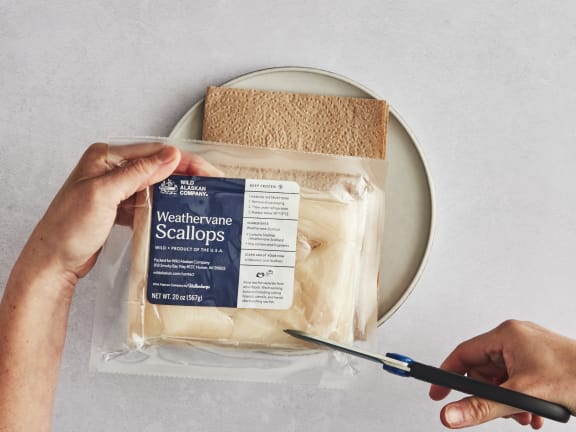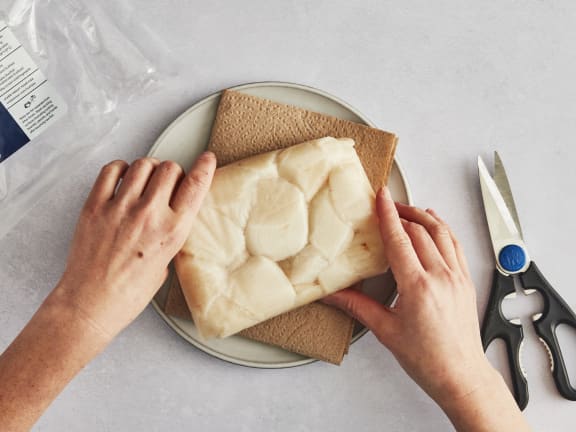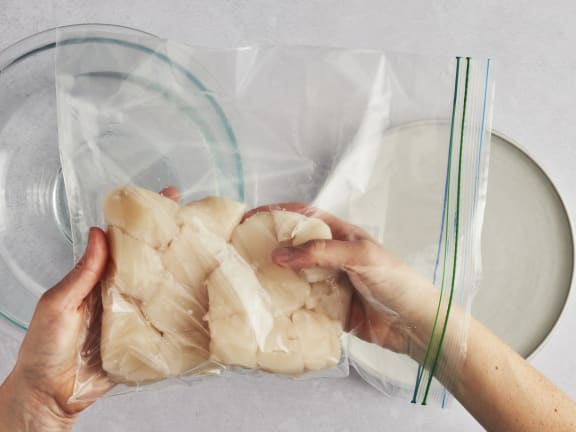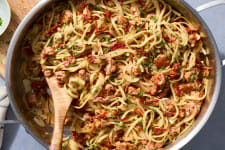Knowing how to defrost frozen scallops properly ensures that you’ll be able to enjoy all of the quality and flavor that they have to offer. Wild-caught weathervane scallops from Alaska are especially sweet and delicate. Thawing weathervane scallops properly is the first step in preparing an extraordinary meal.
Improper thawing technique can lead to waterlogged scallops, which can make it difficult to sear scallops. More importantly, thawing scallops the wrong way can potentially set you up for food safety issues.
Luckily, defrosting scallops is easy. We’ve got you covered here with two different step-by-step methods:
-
The Standard Way (10 to 12 hours)
-
The Quick Way (about an hour)
The Standard Way to Thaw Scallops
Time needed: 10-12 hours, or until defrosted through
Defrosting scallops overnight in the refrigerator is the best way to preserve the integrity of the seafood. This is also the safest way to thaw frozen scallops, since they'll gradually defrost in controlled, cool temperatures that inhibit the growth of harmful bacteria.
 Remove the scallops from their vacuum-sealed packaging.
Remove the scallops from their vacuum-sealed packaging.
 Place your seafood on a plate/tray lined with paper towels or a tea towel that will fit on a low shelf in your refrigerator, arranging them in a single layer if possible. The paper towels will absorb the liquid melting off the seafood.
Place your seafood on a plate/tray lined with paper towels or a tea towel that will fit on a low shelf in your refrigerator, arranging them in a single layer if possible. The paper towels will absorb the liquid melting off the seafood.
 Place this on a low shelf in the refrigerator (typically the coldest spot in the refrigerator).
Place this on a low shelf in the refrigerator (typically the coldest spot in the refrigerator).
 Once the scallops have thawed — this will usually take 10-12 hours —pat them dry before cooking to remove any excess moisture for best flavor and texture. We recommend cooking your seafood within a day or two of being defrosted.
Once the scallops have thawed — this will usually take 10-12 hours —pat them dry before cooking to remove any excess moisture for best flavor and texture. We recommend cooking your seafood within a day or two of being defrosted.
The Quick Thaw Way to Defrost Scallops
Time needed: About an hour
For those days when you don’t have enough time to thaw scallops the standard way, you can use a safe and quick thaw technique that will have you cooking in about an hour.
SAFETY NOTE: Keep in mind, for food safety’s sake, you’ll only want to do a quick thaw if you’re planning on cooking your seafood promptly after thawing.
 Remove the scallops from their vacuum-sealed packaging.
Remove the scallops from their vacuum-sealed packaging.
 Then, place it in a separate, resealable bag that can be sealed tightly.
Then, place it in a separate, resealable bag that can be sealed tightly.
 Next, fill a bowl with cool water. Do not use warm water for food safety reasons. Put the resealable bag of seafood into the bowl of cool water, keeping it completely submerged with something weighty. At the 20- or 30-minute mark, change out the water in the bowl, refilling with cool water, making sure that everything is still submerged.
Next, fill a bowl with cool water. Do not use warm water for food safety reasons. Put the resealable bag of seafood into the bowl of cool water, keeping it completely submerged with something weighty. At the 20- or 30-minute mark, change out the water in the bowl, refilling with cool water, making sure that everything is still submerged.

Once the scallops have thawed, remove from plastic bag.
 Take extra care to pat dry the scallops before cooking to remove any excess moisture for best flavor and texture. Cook promptly after defrosting.
Take extra care to pat dry the scallops before cooking to remove any excess moisture for best flavor and texture. Cook promptly after defrosting.
Be sure to stock your kitchen with sustainably-caught fish and shellfish by sourcing your seafood online from Wild Alaskan Company. You’ll get high-quality, wild-caught seafood delivered straight to your doorstep. Choose your fish subscription box today.





